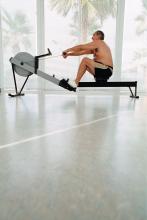Physical performance measures increased by 21% in obese older adults who followed a combination aerobic and resistance exercise routine for weight management, based on data form 141 participants. The findings were published May 17 in the New England Journal of Medicine.
The combination plan scores improved significantly more than either an aerobic exercise or resistance exercise plan (14%), wrote Dennis T. Villareal, MD, professor in the division of diabetes, endocrinology and metabolism at Baylor College of Medicine, Houston, and his colleagues (N Engl J Med. 2017 May 18;376[20]:1943-55).
Obesity in older adults may contribute to frailty and decline in physical function, thus “healthy aging in obese older adults might require an intervention that involves regular exercise,” but findings from previous research suggest that the body may adapt differently to aerobic and resistance exercise, the researchers said.The researchers randomized 40 adults to each of four interventions: aerobic exercise, resistance exercise, combination aerobic/resistance, and control. A total of 141 participants completed the study, and baseline demographic characteristics were similar among the groups.
Overall, among members of the combination group, scores on the Physical Performance Test showed the greatest increase from baseline to 6 months (from 28 to 33 points), compared with the aerobic group (29 to 33 points) and the resistance group (29 to 33 points).
Peak oxygen consumption was significantly higher at the end of the training period than at baseline in the combination and aerobic groups, compared with the resistance group (with increases of 17%, 18%, and 8% increase, respectively). Strength was significantly higher in the combination and resistance groups than in the aerobic group (18%, 19%, and 4% increase, respectively). Both decreases in both lean body mass and bone mineral density were significantly less in the combination and resistance groups, compared with the aerobic group.
Body weight decreased by approximately 9% from baseline in all three exercise groups, but no significant change was noted in the control group.
Adverse events “were relatively few and consistent with coexisting medical conditions,” the researchers said. Exercise-related adverse events included knee, back, and hip pain in the combination group; falling, shoulder pain, and back pain in the aerobic group; and shoulder pain, knee pain, and atrial fibrillation in the resistance group.
The study was limited in part by factors including the physical ability of the study population, which may not represent obese older adults in general, the researchers said. However, “our findings support that the recommendation by the American Heart Association and American College of Sports Medicine to combine aerobic exercise with resistance exercise for overall health extends to obese older adults undertaking weight loss,” they noted.
The study was supported by grants from the National Institutes of Health. The researchers had no financial conflicts to disclose.


